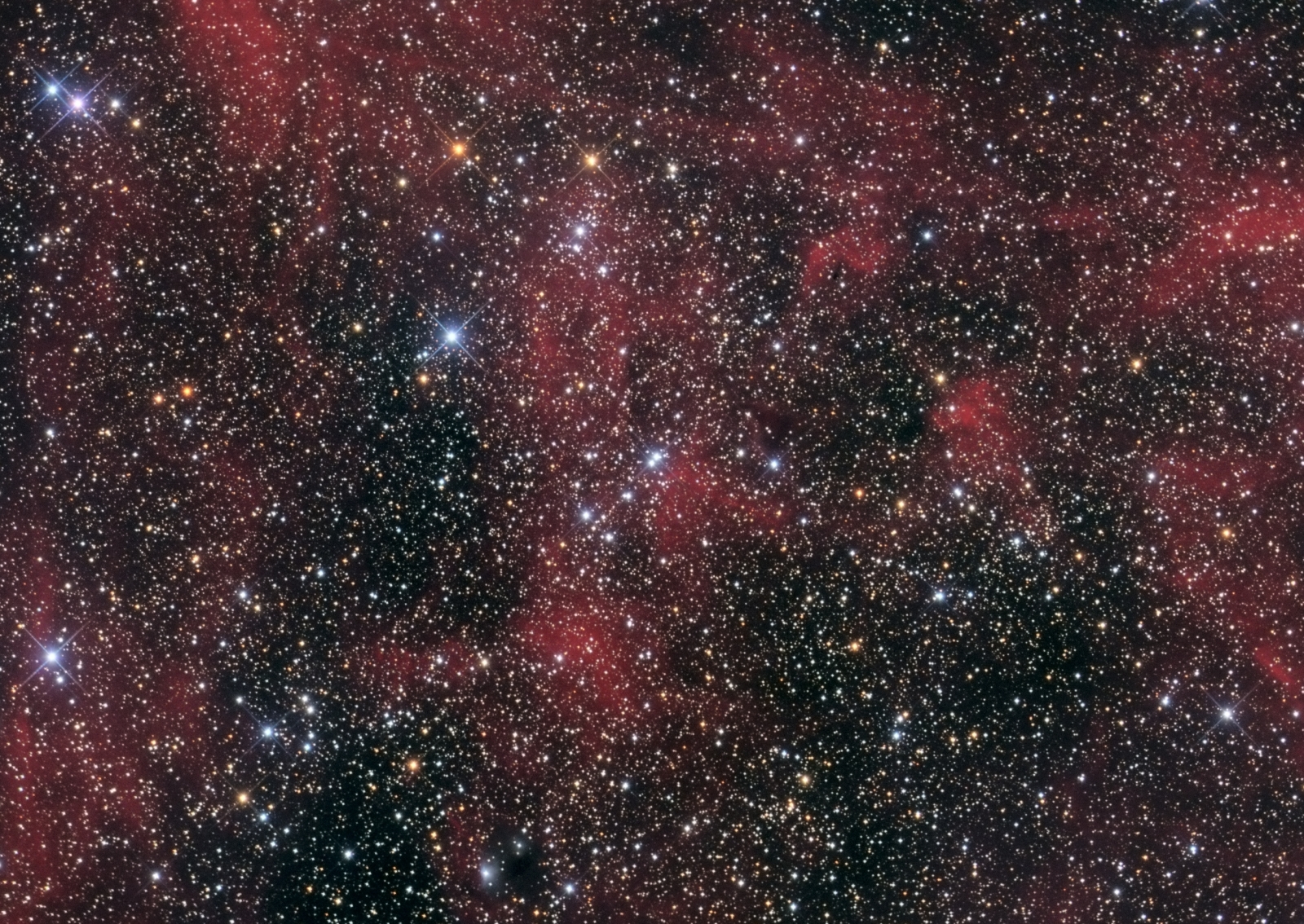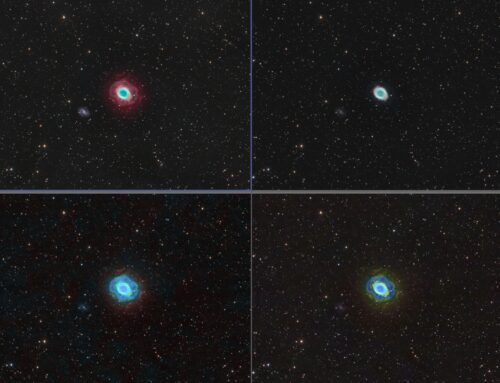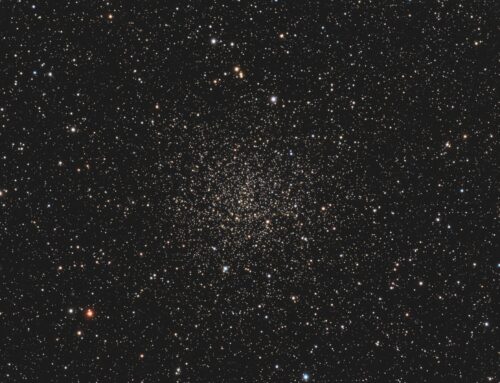NGC6883, Open Cluster with Nebula (Colour)
 Click image for full size version
Click image for full size version
July 25, 2015
NGC6883 is listed as an open cluster, but to me the vast curtains of nebulae surrounding the cluster are much more interesting. The nebula is the eastern part of LBN182, but I couldn’t find much information about it. Much of the nebulosity in this area in Cygnus is about 7,500 light years away, so this nebulosity also likely lies at a similar distance. There seems to be much more written about the open closer of 30 or so stars near the centre of this image, a cluster which I find very difficult to discern because of the densely packed field of Milky Way stars. I love the richness and variety of star colours in this image, including a pinkish star near the upper left of this image (it was also pink in the RGB image without Ha). Also, at bottom left of centre is a small reflection nebula. The nebula is identified as GN20.10.7, but I found no information about its properties or distance.
This image blends the red, green and blue colour channels with data collected through a deep red H-alpha filter. I will soon post a H-alpha-only black and white image of this object.
Tekkies:
SBIG STL-11000M camera, Baader Ha, R, G and B filters, 10″ f/6.8 ASA astrograph, Paramount MX. Guided with STL-11000’s external guider and 80 mm f/6 Stellar-Vue refractor. Acquisition and guiding with TheSkyX. Focusing with FocusMax. Automation with CCDCommander. Calibration, cosmetic correction, registration, integration and all processing in PixInsight. Shot from my SkyShed in Guelph, Ontario. Nearly full Moon for Ha and no moon for RGB. Good to very good transparency and good to very good seeing throughout acquisition.
8x15m R, 8x15mG, 8x15mB and 9x30m Ha unbinned frames (total=10hr30m).
HaRGB
Creation and cleanup: Ha, R, G and B masters were cropped and processed separately with DBE. R, G and B were combined to make an RGB image which was processed with ColourCalibration. The NB-RGBCombine Script was applied with default settings to produce a linear HaRGB image. Using a star mask, blue was boosted in the HaRGB image by using the following PixelMath Expressions: R=$T[0], G=$T[1], B=$T[2]+0.07*H_ALPHA
Linear Noise Reduction: MultiscaleLinearTransform was used to reduce noise in the background areas. Layer settings for threshold and strength: Layer 1: 3.0, 0.5 Layer 2: 2.0, 0.35 Layer 3: 1.0, 0.2 Layer 4: 0.5, 0.1
Stretching: HistogramTransformation was applied to make a pleasing yet bright image. TGV Noise was applied and the image was re-stretched to reset the black point.
Synthetic Luminance:
Creation and cleanup: The cleaned up Ha, R,G and B masters were combined using the ImageIntegration tool (average, additive with scaling, noise evaluation, iterative K-sigma / biweight midvariance, no pixel rejection).
Linear Noise Reduction: MultiscaleLinearTransform was applied to reduce the noise. Layer settings for threshold and strength: Layer 1: 3.0, 0.5 Layer 2: 2.0, 0.35 Layer 3: 1.0, 0.2 Layer 4: 0.5, 0.1
Stretching: HistogramTransformation was applied to make a pleasing yet bright image. TGV Noise was applied and the image was re-stretched to reset the black point.
Combining SynthL with HaRGB:
The luminance channel of the HaRGB image was extracted, processed and then added back into the HaRGB image as follows:
1. Extract luminance from the HaRGB image.
2. Apply LinearFit using SynthL as the reference.
3. Use ChannelCombination in Lab mode to replace the HaRGB’s luminance with the fitted luminance from step 2.
4. LRGBCombine was then used to make a SynthLHaRGB image.
Final Processing
Overall contrast was increased and brightness increased slightly with the Curves tool. Saturation in nebula and stars was increased slightly.
Star shapes were smoothed and sizes reduced by applying MorphologicalTransformation twice through the same star mask. The first pass used the Midpoint operator, with default settings. The second pass used the Erosion operator with a strength of 0.17 and 4 iterations. A light unsharp mask was then applied.
Image scale is about 1.1 arcsec per pixel for this camera / telescope combination.






Leave A Comment